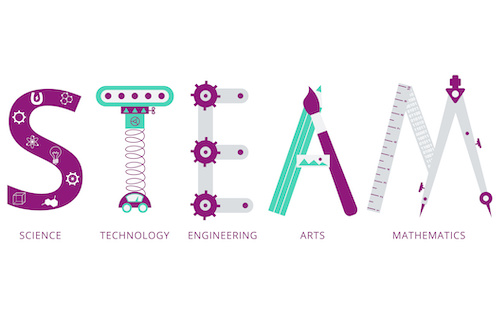Key points:
- STEAM education creates capable and insightful students
- Elementary-level STEM education fosters our future innovators
- 4 ways to use ChatGPT in your STEM classroom
- For more on STEAM education trends, visit eSN’s STEM & STEAM page
STEAM education–science, technology, engineering, arts, and mathematics–prepares students for success beyond high school by helping them develop much-needed durable skills such as critical thinking and problem-solving.
An integrated STEAM education also puts students on the path to success with higher test scores, stronger attendance records, better disciplinary records, and increased engagement and graduation rates.
STEAM education is trending at an opportune time: The COVID-19 pandemic caused learning loss across the board, and a STEAM-centered curriculum that engages students while weaving important 21st-century education principles into real-world lessons is critical for success.
Let’s take a closer look at STEAM education:
What is an example of STEAM education?
Makerspaces are a great example of STEAM learning, letting students combine creativity and art elements into more traditional STEM topics. School makerspaces have emerged as centers of creativity, problem solving, collaboration, and more. These skills–often referred to as soft skills, but also known as durable skills for their importance in the workplace–are a focus of 21st-century classrooms. These days, school libraries often include makerspaces and librarians are becoming well-versed in the coding, robotics, engineering, and tinkering skills necessary to help students bring their ideas to fruition. Let’s look at some STEAM education facts: Here are 5 resources (digital and non-digital) for school makerspaces that might be worth a look.
What does STEAM do for education?
As STEM has risen in prominence over the past decade, arts education has yet to achieve the same recognition and integration. In order to provide a rich, robust, and inclusive curriculum for youth, STEM needs to evolve to STEAM. And in many ways, that transition is already taking place as technology and engineering drive the next wave of art and creative expression. You can’t have one without the other. As our digital world encompasses new storytelling mediums across design, audio engineering, music production, digital art, and more, new unique skill sets are required to prepare young people for careers of the future. STEAM education principles need to become embedded into media production, music production, and graphic design to enable the next wave of innovation and creativity needed for these major technological shifts. STEAM education lesson plans can incorporate so many learning principles. Here’s why creativity is essential in today’s curriculum.
What is STEAM and STEM activity?
Much STEM and STEAM activity happens in labs. A STEM or STEAM lab is an environment where students, irrespective of grade, can come together and actively participate in hands-on STEM and STEAM learning. These educational spaces encourage active learning and problem solving. In these STEM laboratories, students can develop their science, engineering, and mathematics skills by using technology to create, collaborate, and complete projects–learning and applying knowledge to find new solutions. Imagine a technology-enhanced learning environment where everything is student-centered and supports theme and project-based learning–that’s a STEM lab! And these are just a few STEM and STEAM education examples. Here are 4 ideas to consider when creating a STEM or STEAM lab.
What is the value of STEAM education?
Science, technology, engineering, and math are broad but dynamic subjects that contain innumerable and specific learning concepts. Arts and sciences have traditionally been perceived as different subjects with few commonalities, and STEM programs often omit the arts from the conversation. But with a STEAM-centered curriculum, students are trained to introduce design, agile thinking, and creative solutions to solve social and scientific problems and bring new inventions to fruition. What’s more, a multi-subject approach to a STEAM education promotes deeper conceptual learning and career self-determination, and prepares youth for interdisciplinary STEAM careers in a rapidly changing workplace. So, what’s the impact of STEAM education? A STEAM learning approach encourages collaboration to understand and distill new concepts. By integrating the arts, a STEAM-centered curriculum uses tools such as quantitative visualization or fine arts imagery to deepen one’s understanding of science, math, and technology. Here’s why students will benefit from STEAM learning.
What are 3 benefits of STEM?
A new study at the University of Missouri–in partnership with Harvard-Smithsonian researchers–shows that when colleges host ‘STEM Career Days,’ the students who attend are far more likely to pursue a career in a STEM-related field. The findings not only highlight the benefits of college recruiters introducing high school students to STEM-related opportunities, but they can also help increase and diversify the STEM workforce in the United States. The benefits of STEAM education and STEM learning help students develop much-needed skills such as problem-solving, critical thinking, and collaboration. Students learn how to navigate challenging situations regardless of what career field they pursue. STEM learning benefits are invaluable.
- Friday 5: Virtual field trips - April 26, 2024
- Google, MIT RAISE launch no-cost AI training course for teachers - April 26, 2024
- 4 ways to support work-based learning - April 23, 2024

